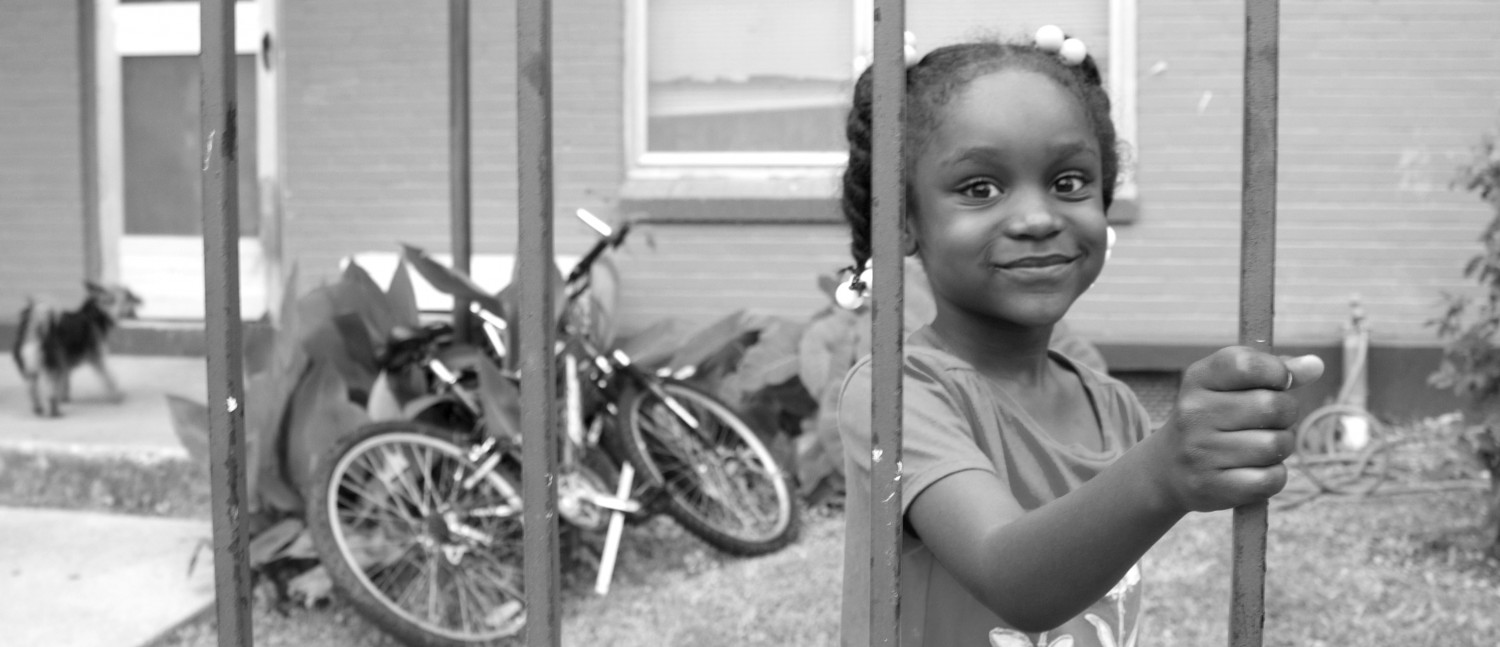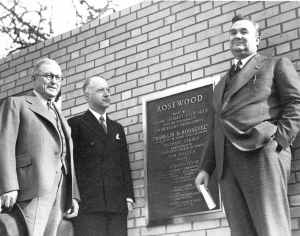The sound of children’s laughter, the hushed whispers of little girls, and the hollow leathery cadence of a basketball beating against cool asphalt are the soundtrack of a spring afternoon at Rosewood Courts. The smell of rain is in the air, and women still in their work outfits scamper out of their homes to take their clothes from the line—they have no dryers. The gray sky carries the white puffs of smoke that seep through the nostrils and parted lips of old men who sit outside on their stoops, which are set to be demolished, along with most everything else, if all goes according to the Housing Authority’s plan.
Rosewood Courts, just off 11th and Chicon, is a public housing complex that is as important to local history as it is to American. Built in 1939, it was the first black public housing project in the nation, thanks to the lobbying efforts of then-congressman Lyndon Baines Johnson. Today there are plans to demolish most of the buildings, at least temporarily displacing the residents, and replace the site with mixed-income housing.
The redevelopment of Rosewood Courts is still in its planning stages and is being led by the Housing Authority of the City of Austin. Every year, HACA deploys its Planning and Development team to assess all 18 of its properties to determine their physical needs. They consistently find Rosewood Courts to be in the greatest state of disrepair.
Exposed pipes, poor electrical wiring, and lack of central heating or air conditioning were all cited as concerns. “Rosewood is the type of property we could put tons and tons of money into and it probably wouldn’t be up to today’s standards,” said Eileen Schrandt, who works at HACA and is intimately involved with the planned redevelopment of the property.
Long-time residents of East Austin remember a very different neighborhood. “Rosewood Park taught me how to swim, and compete in sports,” recalls Beverly Felder, whose mother lived in a house nearby Rosewood for 70 years. “Growing up, we wanted to live in the Rosewood projects, but we didn’t realize we owned our own home. It was a beautiful place,” she said. “This is Eden.”
Randy Tovar, 55, remembers his childhood in Austin’s east side, where he graduated from the same school that now employs him as a custodian, East Side Memorial. He lives in the same house he grew up in, just a few blocks away from Rosewood Courts.
“We used to sit on this hillside every Friday night, families from all over the neighborhood, kids playing everywhere, and we’d sit on that hill and watch this group play guitar,” Tovar said. “That’s what we’d do every Friday night. The community was that tight knit,”
In 2012, HACA hired architecture and engineering firms to come up with an estimate of the likely cost of improvements to the structural integrity of the buildings. According to Schrandt, they estimated about $115,000 in repairs would have to be invested in each housing unit. There are 124 units at Rosewood Courts.
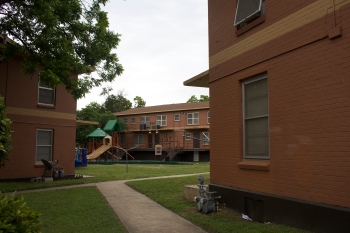
Chronically underfunded, HACA reports $25 million in capital needs as finances from the US Department of Housing and Urban Development have dropped by over half a million in the last decade. This isn’t for lack of need, HACA has 8,000 families on its waiting list for public housing, and some have been on it for as long as fifteen years.
This pressed HACA to seek out alternatives. In 2012, HACA applied for a Choice Neighborhoods planning grant, part of a program launched by HUD which lists as its main priority “to replace distressed public and assisted housing with high-quality mixed-income housing.”
Choice Neighborhoods has dispersed as much as $30 million to other cities around the country to assist with their public housing issues, well above what would be required to repair Rosewood Courts according to HACA’s own estimates.
On April 9, HACA submitted its revitalization plan, dubbed Rosewood Choice, to HUD and will likely know by November if HUD will grant them $30 million to go forward with implementation. The plan would tear down all but six of Rosewood’s two dozen buildings, demolishing all the buildings built in 1941 and only preserving some of the buildings built just two years earlier.
As it stands today, Rosewood Courts is strictly public housing, serving as a safety-net for Austin’s most economically vulnerable. The plan would keep all 124 public housing units, granting any family that might be displaced during the renovation process the right to return.
“Probably about two-thirds of the people plan on staying,” Schrandt said. “Some can’t wait to leave, though.”
However, the plan would also include Section 8 housing, and some of the housing will be wholly unsubsidized, putting part of the property on the market for anyone who desires to live close to downtown and the University of Texas and can afford to do so. According to HACA’s research, in 2014 the average sales price of a house in the planning area was $301,389.
Eileen Schrandt
Many residents of East Austin who grew up there are concerned with the increasing level of development in the area, and see the revitalization project in Rosewood as a microcosm of the changes they’ve grown so reluctantly used to seeing.
“There’s a method to that madness, and we’ve seen it before,” reported Mrs. Felder. Her daughter, Myra, elaborated, “It’s great to have diversity but with that diversity, keep the culture of the community intact.”
They spoke inside Mt Calvary Baptist Church around a table that had just been cleared of the coffee and doughnuts usually served to parishioners before Sunday services begin. The church was erected in 1939, the same year the first buildings went up at Rosewood Courts. Less than half a mile separates the two. The pastor that built the church lived 100 years and passed the flock onto his grandson, the current pastor.
Mt Calvary has been officially recognized as a historical landmark, a designation the pastor’s father, Deacon Willie Lewis, believes should be shared with Rosewood.
“I think it should be treated just like any historical building,” the Austin resident of 56 years said. “I don’t have a problem with them updating the property, but to take part of it and make it privately owned is ridiculous.”
Dr. Fred McGhee, a historical anthropologist and founder of the organization Preserve Rosewood, agrees. McGhee suggests that putting Rosewood on the National Register of Historic Places would open up public funding that can go toward making the necessary improvements to the buildings without demolishing them and replacing them with mixed income housing.
HACA supports putting Rosewood on the National Register, but not on the criteria McGhee is pushing for, which would include architecture and archaeology, and thus prevent them from moving ahead with demolition.
“Housing Authorities are under a big squeeze,” McGhee said, referring to the rollback of federal funding for public housing. “The policy environment in which we live is that public housing is bad, it was a failed social experiment that needs to go away.”
In an interview McGhee declared, “This issue is largely wrapped up with me as a person, because I’ve been in Austin now the guy who has sort of been the most vociferous advocate for public housing.” Shortly after making those comments, while attempting to give a tour of the property to the authors of this story, McGhee was informed by the management of Rosewood Courts that he was no longer welcome on the property and told he must leave. The justification for such an order was that he had been harassing residents and spreading misinformation.
As of this writing, no documentation verifying either claim could be obtained.
“If I told you that 200,000 public housing projects have been destroyed in the last 20 years, that wouldn’t surprise you?” asked Dr. Mercedes De Uriarte in an office with walls lined with books carrying titles such as New Deal Ruins and The Possessive Investment in Whiteness. She is a professor of Journalism at UT and a gentrification expert who has penned articles, published chapters, and led research projects on the subject for over 30 years.
“Austin got its first democratic government when the present people on City Council were sworn in on January [6th] of this year. All of that gentrification began when there was no representative for people living in east Austin,” she said.
Mercedes de Uriarte
In November citizens of east Austin got to vote for the first time for their own representative on City Council. They chose Ora Houston, who has long lived in the area and is a supporter of McGhee’s Preserve Rosewood organization. Prior to the new single-member district system, members were selected in city-wide elections, where the more economically prosperous citizens of west Austin had a disproportionate share of the votes.
“The people who were making decisions about Rosewood, and who was going to tear down this, were people who were elected at large,” De Uriarte said. “The people who voted were the people on the west side.”
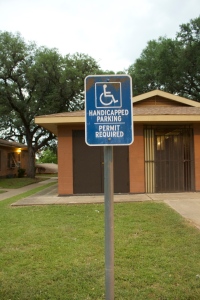
The ever-shrinking revenue stream to the Housing Authority from HUD is indeed a national phenomenon. HUD funding for new public housing has been zero since 1996, and since that year nearly 300,000 existing units have disappeared, despite growing need for subsidized housing and deepening income inequality.
“This is about funding,” Schrandt said. She estimates that when she began working for HACA eight years ago HUD provided about $4 million to go toward the maintenance of all 18 of the properties, “which really turns out to be not that much money at all. Now we’re at about $2.1 million, so in the last 8 years it’s been cut in half. There isn’t enough money.”
This is due to Congress and its ongoing practice of slashing HUD’s budget. According to the San Francisco based Western Regional Advocacy Project, the corporate bailouts of 2009 that cost taxpayers around $800 billion dollars “surpasses the entirety of funding allocated for homeless assistance and affordable housing over the last three decades.”
Edward G. Goetz, whose book New Deal Ruins is a careful study of the defunding of public housing around the country, makes the argument that there is a racial factor to this practice.
“Low-income African-Americans have borne a disproportionate burden of displacement and forced relocation over the past 20 years. The projects we have demolished during this period have typically had higher proportions of African-American residents than similar developments left standing,” he writes.
“The United States has always structured disadvantage so that some people are always kept in a very disadvantageous place,” de Uriarte said.
Austin, like most American cities, has a history of selective disenfranchisement of people of color. In 1928 the Austin City Council, under the pre-2014 system some have regarded as insufficiently democratic, submitted a resolution to the City Plan Commission to institutionalize racial segregation, moving the “undesirable” minority communities east of what would become IH-35, and resulting in 90% of industrial zoning being placed in the area, including power plants and landfills.
“It is our recommendation that the nearest approach to the solution of the race segregation problem will be the recommendation of this district as a negro district; and that all the facilities and conveniences be provided the negroes in this district as an incentive to draw the negro population to this area. This will eliminate the necessity of duplication of white and black schools, white and black parks, and other duplicate facilities for this area,” the plan read.
“Right at 12th and Chicon, they called that East End…because during segregation-time everybody would gather on that corner to go work on the west side of town,” says Domonica Ivory-Foster, parishioner at Mt Calvary.
While the plan was ruled unconstitutional in the 1940s, shortly after construction of Rosewood Courts was completed, its impact can be traced right up to the present day.
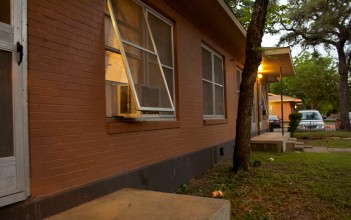
“You wouldn’t see other races too much on this side of town. They considered east Austin a slum,” Ivory-Foster said. “Now you hardly ever find black-owned businesses. If you do they’re scattered, and even with diversity they don’t patronize our businesses so it’s hard for us to stay in business.”
“They’re steadily pushing us out,” she said, referring to an article in the Austin American-Statesman which found that of the top 10 fastest growing cities in the nation, Austin is the only one with a declining black population.
A 2014 study from the University of Texas at Austin found that in the first decade of the new millennium Austin’s population grew by 20.4% yet the black population declined by 5.4%, mostly leaving for more affordable living in surrounding towns like Pflugerville.
A study conducted by the University of Toronto’s Martin Prosperity Institute and published earlier this year, found that Austin is today the most economically segregated city in the United States. East Austin residents feel the affects more acutely than others.
“One retort that people often make when discussing the history of racism is ‘We should not dwell on the past,’” Ta-Nehisi Coates wrote in a 2013 piece for the Atlantic entitled The Ghetto is Public Policy. “It’s an opportunistic claim—But more to the point, this is not the distant past. The men and women who suffered at the hands of…the racist aspects of New Deal legislation are very much alive today. Furthermore, their children are alive and the effects of that policy on the country are fairly obvious.”
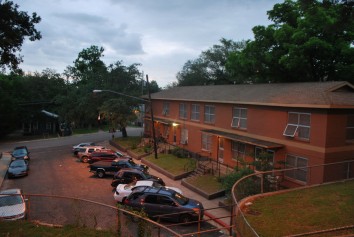
The sun is sinking and the sky over Rosewood Courts is turning a charcoal color. The air is heavy and the smell of rain is so real one could almost drink it. Parents are peeking their heads out of their front doors to call for their children to come inside, it’s getting late and a storm is brewing.
One of those parents is Shannon Jones, who has a little boy named Matthew who is a first grader at Blackshear Elementary, just down the street. She participated in the community outreach part of HACA’s Rosewood Choice planning program.
“When you don’t have a place to go, and they give you that key, I walked into this unit—It was beautiful,” Jones said, referring to when she first moved into Rosewood. “It was wonderful.”
When she moved to Rosewood with her son, she recalls hearing about the planned demolitions from neighbors. “I got involved because I moved out here, I was very happy, and then I heard people telling me ‘they’re gonna tear this place down,’ and I was like ‘What?’ So that’s why I jumped on the bandwagon.”
That bandwagon was a paid internship with HACA which required her to organize community meetings to assist in the planning process for the future of Rosewood, and to speak on behalf of the residents’ concerns. Despite playing a role in the Choice Neighborhoods planning process, she remains uncertain of what the result would be if the plan is implemented.
“I’m not sure it’s going to be the same Rosewood. I think there’s going to be a lot of non-brown people living out here,” Jones said. “I think there’s still going be subsidized housing in parts of Austin, but not like this. I think eventually they’re all going to get smaller and smaller, because if you go…two blocks up, you see all these houses and you’re like ‘Wow.’”
Matthew, who seemed more interested in examining fly paper and feeding the fish and smiling than doing his homework, is at the center of Jones’ concerns about the future. She juggles work, school, and childcare all while dealing with the uncertainty of life in public housing.
She fears the neighborhood will lose its cultural heritage.
“When you live in a place that you don’t see a whole bunch of black people, and you’re raising a child, that’s very important,” Jones said. “So when you’re raising a black child or a Mexican child or whatever brown color, you want them to be around other people like them, because it messes them up culturally [when they’re not], they don’t understand things and that’s hard.”
Jones is attending Austin Community College with a major in the science field and is striving to graduate with honors because she’s promised herself that if she succeeds, she and her son will visit Paris, a long-time dream of hers. However, she’s open to settling for California. “He wants to go to Legoland,” she said, peering over at Matthew.
If Jones and her son are displaced during the renovation process, it is uncertain if he’ll have to change schools. “We have a lot of kids in that younger age group that go to Blackshear, so we’ve talked over the past few years with the principal about how do we keep those kids there,” Shrandt said. “There would have to be certain points of pickup, we can’t be driving around to go and pick everybody up. But there will probably be pickup areas and most likely HACA will pay for that transportation,” she continued.
“Those logistics aren’t totally worked out yet, but they’ve been talked about,” Shrandt assured.
If Matthew’s mother decides to stay at Rosewood, he’ll likely attend East Side Memorial High School. Going to the school as a visitor requires you to ring a bell at the front entrance, as all the doors are locked for security reasons. However, if you time it right, you might happen upon a friendly student there who will hold open the door and greet you with a smile, no questions asked.
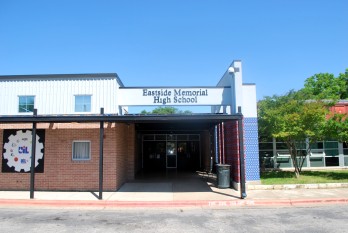
The school has had five principals in eight years, and several charter schools have been mounted along its periphery, drawing away students and leaving East Side Memorial with a student body of roughly 500. No teacher has taught there longer than 13 years.
“Everybody knows Marty,” students and staff say, referring to Marty Martinez, the school maintenance man. With straight silver hair and a matching goatee, Martinez had a lot to say about his school. “We’re a political school.”
He mentioned an incident two years ago where a large group of current students, of their own volition, went to an AISD Board of Trustees meeting to demand their school stay open and not be shut down, which the district was considering. That, according to Martinez, didn’t get any press attention.
“Instead, they covered the brawl that happened in the cafeteria,” Martinez said. “A few chairs got thrown around. That was our first fight of the year.”
To Martinez and de Uriarte, this is a distorted portrayal of the school.
“You see the ways in which the press keeps refreshing stereotypes,” de Uriarte said. “So we don’t ever move passed the old stereotypes, we may call them something a little bit different.”
Someone who is fighting those stereotypes every day is the music teacher at the school, Meghan Buchanan. Her office is covered in papers and the computer she has at her desktop is a Dell circa roughly 2003. However her students are comfortable in the classroom, one even approaches the piano at the front of the room and begins to play an extemporaneous composition.
“A lot of our students move, and they come and go throughout the year,” says Buchanan, who isn’t uncomfortable talking to her students about gentrification. “It’s the rent issue and the taxes going up. Not very many of them have cars, but if they have rides they’ll stay at East Side and commute from Pflugerville, from Lockhart, from Del Valle to stay here just because they love their friends and the school.”
Buchanan echoed Martinez’s assertion that East Side Memorial is a political school, and mentioned that the students are not unaware of the changes happening in their neighborhood. “They all live in the neighborhood and talked about how now the streets are lit at night and the pavement is fixed if there was a pothole, like, immediately,” she said.

According to Buchanan, many of the students “were frustrated that that didn’t happen until the rich white people came in, or whatever their perception of what happened. We asked for help and nobody gave it to us, they come in with this money and ask for help and the city’s on it.”
She mentioned a student whose family received a two-week eviction notice, for renovations, but because the rent increased they couldn’t move back.
“He said they stared out their window at this old broken down pool for the last year or two that he lived there, and now that they renovated and raised the rent the pool is awesome, everything’s fixed, but they don’t get the benefits of it,” Buchanan said.
Another girl confided in her that “to pay the taxes, [her father] sold the car, he really tried hard to keep the house in the family, and he was doing it and they were able to stay, until somebody came to his door and said ‘I’ll give you cash for your house.’ She said he couldn’t refuse it, even though he probably could’ve gotten more.” They lost the house they owned, moved to Manor, and are now renting.
Such is the reality for many east Austin residents.
Tovar, the custodian at the school who grew up in the neighborhood and still lives in his childhood home, talked about how he and his wife are being forced to consider moving away.
“I don’t think that thought ever crossed [my parents’] minds. Like, ‘Hey, I’m gonna have to bail out because this is getting too expensive,’” Tovar said.
Yet, he’s still determined to stay in the only place he’s ever called home. “I just tore up a letter yesterday. [It was from] an attorney, and he had clients coming in from California and they were very interested in my property.”
He said he usually keeps the letters, but on that particular day he couldn’t stop himself from tearing it up.
“I don’t want to hear this right now,” Tovar remembers thinking.
Back at Rosewood Courts, the wind howls through the trees. Lighting is poor and the children have all gone inside. The occasional fat drop of rain lands with a thud, and a teenage boy, likely a student at East Side Memorial, carries a laughing girl of the same age on his back to a destination only they can be certain of.
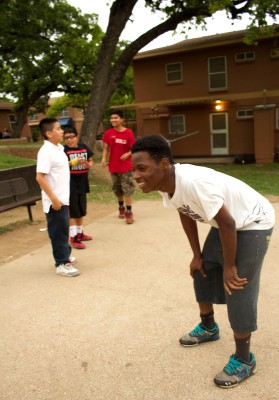
What remains uncertain is the future of this place. There are unanswered questions, such as how exactly will displaced students get to school. What will happen to their parents who have jobs in the area and are forced to move elsewhere? Displaced residents will have the right to return and pay the same rent, but will their income have changed and thus their eligibility?
HACA says that it will work closely with residents to connect them to their support networks and ensure minimal disruption to their daily lives. Yet the specific mechanisms of doing so, such as paying for transportation, guaranteeing shelter or work, are not provided. This makes de Uriarte skeptical about the proposal.
“It’s hard to believe, thinking now, in terms of people’s prejudices and biases that you’re going to have developers who think it’s a really good idea to build expensive things, and then put poor people in there,” de Uriarte said. “It’s always good to ask, who benefits?”
Suddenly a blink of white light and a crash of thunder shakes the ground that used to be Emancipation Park, and the air is heavy with the anticipation of the ensuing downpour. Emancipation Park was the site of Austin’s first Juneteenth celebration, commemorating the day Texas slaves learned that they were free people and had been for nearly two years. The State of Texas evidently took just that long to get around to telling them.
Eileen Schrandt, startled by the sudden boom of weather, laughed off the shock. Many of the residents know her name, and she knows the first names of many of the residents.
“It means a lot to me, the whole project does, and I’m going to represent HACA in a good way,” Schrandt said. “It’s not like we’re making all the decisions, obviously these people have been involved. You better write that,” she laughed.
HACA’s stated goal is to preserve public housing at Rosewood Courts, however twenty years down the line Schrandt says she doesn’t believe that goal will have been met.
“I see affordable housing, but I don’t see public housing because I think public housing as a HUD funding stream is going away,” Schrandt said.
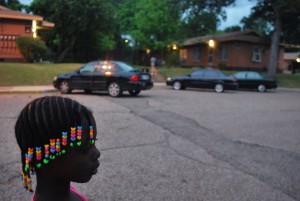
The thunder crashes and the rain pours on Rosewood Courts now, and the final question is will this shower bring the kiss of new life to the people and their neighborhood, or will their history be forever washed away into the distant and forgotten past? On May 16 the historic status of Rosewood will be considered by the Texas Historical Commission, and they will make the decision whether to pass it to the federal level in the final phase of placing it on the National Register of Historic Places. Perhaps then a ray of sunlight will cut through a raincloud, and we’ll finally see with a little more clarity Rosewood’s uncertain road ahead.
